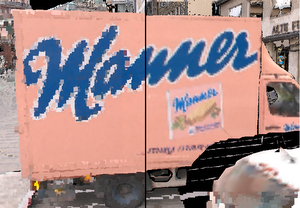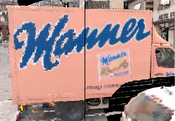Information
- Publication Type: Technical Report
- Workgroup(s)/Project(s):
- Date: April 2012
- Number: TR-186-2-12-01
- Keywords: screen triangulation, point rendering, nearest neighbors, screen-space, point clouds
Abstract
This technical report documents work that is a precursor to the Auto Splatting technique. We present a rendering method that reconstructs high quality images from unorganized colored point data. While previous real-time image reconstruction approaches for point clouds make use of preprocessed data like point radii or normal estimations, our algorithm only requires position and color data as input and produces a reconstructed color image, normal map and depth map which can instantly be used to apply further deferred lighting passes. Our method performs a world-space neighbor search and a subsequent normal estimation in screen-space, and uses the geometry shader to triangulate the color, normal and depth information of the points. To achieve correct visibility and closed surfaces in the projected image a temporal coherence approach reuses triangulated depth information and provides adaptive neighbor search radii. Our algorithm is especially suitable for insitu high-quality visualization of big datasets like 3D-scans, making otherwise time-consuming preprocessing steps to reconstruct surface normals or point radii dispensable.Additional Files and Images
Weblinks
No further information available.BibTeX
@techreport{TR-186-2-12-01,
title = "Interactive Screen-Space Triangulation for High-Quality
Rendering of Point Clouds",
author = "Reinhold Preiner and Michael Wimmer",
year = "2012",
abstract = "This technical report documents work that is a precursor to
the Auto Splatting technique. We present a rendering method
that reconstructs high quality images from unorganized
colored point data. While previous real-time image
reconstruction approaches for point clouds make use of
preprocessed data like point radii or normal estimations,
our algorithm only requires position and color data as input
and produces a reconstructed color image, normal map and
depth map which can instantly be used to apply further
deferred lighting passes. Our method performs a world-space
neighbor search and a subsequent normal estimation in
screen-space, and uses the geometry shader to triangulate
the color, normal and depth information of the points. To
achieve correct visibility and closed surfaces in the
projected image a temporal coherence approach reuses
triangulated depth information and provides adaptive
neighbor search radii. Our algorithm is especially suitable
for insitu high-quality visualization of big datasets like
3D-scans, making otherwise time-consuming preprocessing
steps to reconstruct surface normals or point radii
dispensable.",
month = apr,
number = "TR-186-2-12-01",
address = "Favoritenstrasse 9-11/E193-02, A-1040 Vienna, Austria",
institution = "Institute of Computer Graphics and Algorithms, Vienna
University of Technology ",
note = "human contact: technical-report@cg.tuwien.ac.at",
keywords = "screen triangulation, point rendering, nearest neighbors,
screen-space, point clouds",
URL = "https://www.cg.tuwien.ac.at/research/publications/2012/TR-186-2-12-01/",
}


 tech-report
tech-report
